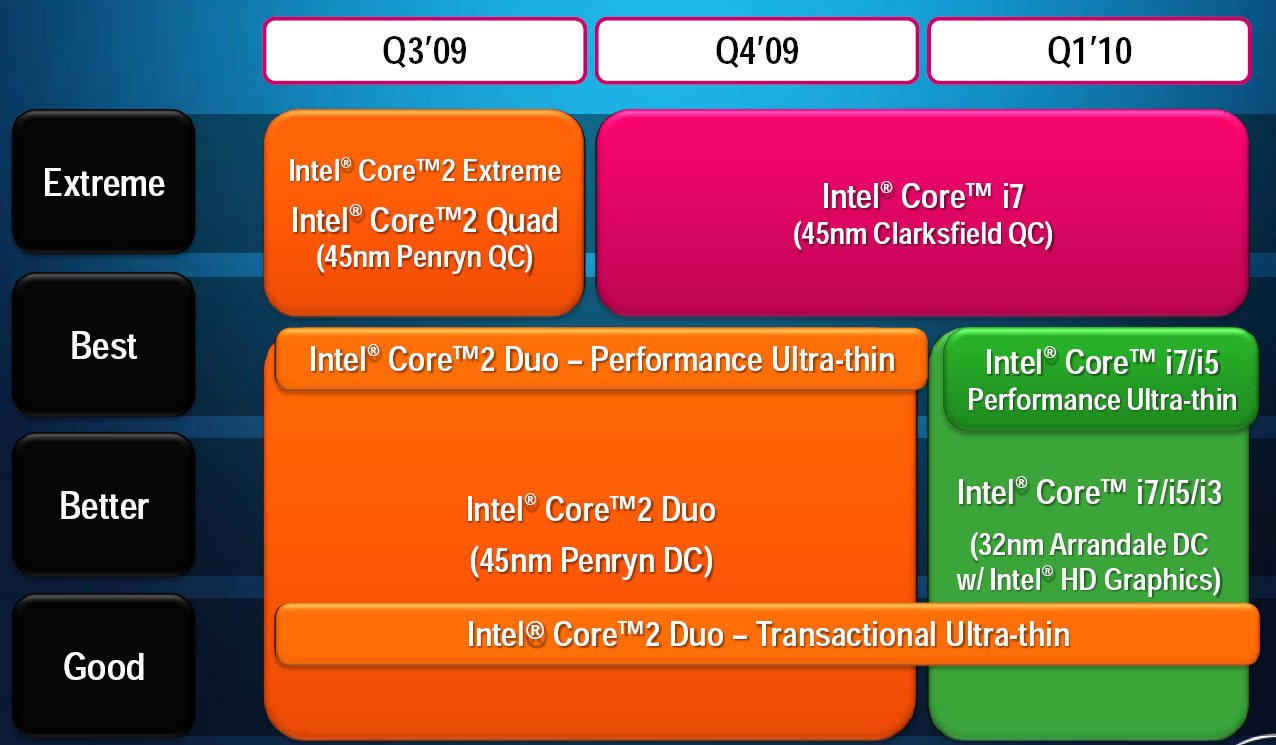Intel’s Mobile Core i5 And Core i3: Arrandale Is For The Rest Of Us
Introduction
Don’t you hate it when you’re on a plane, three-quarters of the way through your favorite movie, when the notebook you’re watching on runs out of juice? It takes a miserly mobile platform to last an entire feature film and continue computing on after it’s over, and those are fairly few and far between.
The first Arrandale-based notebook to land in our lab is armed with a full complement of media-oriented functionality, but I'll spoil the suspense and come right out with the fact that it can’t quite finish a Blu-ray movie.
That’s not to say the Asus K42F isn’t a winner when it comes to longevity. We made it 120 minutes through Transformers on Blu-ray before the unit’s 63Wh battery gave out. More impressive, the K42F played back 300 in its entirely (on DVD) and still had 44% of its battery left.
In comparison, back in October, we gave you a look at Intel’s Mobile Core i7-920XM—the first Nehalem-based processor to tackle the desktop replacement notebook market, not counting the Bloomfield-based behemoths we've seen. With a 55W TDP, though, and paired up to a discrete graphics adapter, we were actually somewhat disappointed with the system’s power consumption, even if it did deliver superior performance versus previous-generation Montevina-based machines. That machine only made it through the first 44 minutes of 300.
But Intel’s Clarksfield-based processor was never meant to be the shining star in the company’s Calpella mobile platform. And ever since our desktop replacement preview, we’ve been anxiously awaiting Arrandale, the processor that’d power notebooks for the rest of us: from medium-sized designs to thin-and-lights and ultra-portables. Finishing our DVD movie with almost half of its battery left was quite a feat for Asus' first Arrandale offering. What else can the little 14" notebook do well?
A Platform Built To Dominate
Of course, Arrandale is the mobile equivalent of Clarkdale, which we detail in Intel Core i5-661: Clarkdale Rings The Death Knell Of Core 2. It leverages the same 32nm high-k / metal gate manufacturing process, which helps pull down the power consumption of these new chips to 35W, 25W, and 18W, depending on the model you choose.
Get Tom's Hardware's best news and in-depth reviews, straight to your inbox.
“But wait,” you say. “Isn’t that the same as most of Intel’s 45nm Core 2 Duo standard-voltage and medium-voltage chips? Where’s the improvement?”
Like Clarkdale, Arrandale includes two die on a single package—the 32nm silicon consists of the dual-core, Hyper-Threading-equipped processor, while the 45nm die includes graphics, memory control, and PCI Express. Integrating all of that functionality into the CPU negates the need for a traditional northbridge. So, again, we’re presented with a two-chip platform, akin to Lynnfield/P55 and Clarkdale/H55/H57. Axing the middle chip—the GM45 graphics and memory controller hub, in the Montevina platform—eliminates a component that uses up to 12W. So, while Arrandale itself doesn’t represent a huge power savings, the platform it enables has the potential to both outperform and outlast any comparably-equipped notebook today.
Complementing the new processors is a host of chipsets and Centrino-branded wireless modules. Moreover, we have one of the first examples of Arrandale in action here in our lab. Today we’ll be taking Asus’ new K42F notebook for a spin and comparing it against an HP notebook configured as similarly as possible.
Current page: Introduction
Next Page The Arrandale Lineup: Something For (Almost) Everyone-
burnley14 Well played, Intel. You've been knocking it out of the park lately, keep up the good work.Reply -
I'm looking forward to getting an HP laptop with the Arrandale Core i5 processor in the near future.Reply
-
It's going to be interesting to see the performance/battery time of the LM and UM processors as I'm in the market for a thin-and-light myself.Reply
Performance is good but I'm hoping for a viable update to the CULV offerings of yesterday. -
Computer_Lots Looks like there are finally some replacements for the Atom, at least in efficiency anyway. Too bad the price is currently too high for the UM versions of these processors to make their way into netbooks. I would guess that even the i5-520UM would destroy the Atom in every benchmark, except maybe power consumption.Reply -
HansVonOhain C2D was one of the longest living platforms. But newer tech will replace slower processors.Reply
Keep it up intel. I do hope that AMD will release some new chips that will be able to compete with intel offerings. -
jasperjones ^^^ true that. arrandale will further diminish AMD's role in the mobile processor market. and there's nothing coming up before may.Reply -
Luscious Chris, the dv4 series from HP has a 12-cell extended battery available as well rated for 94Wh 2.2A. Once HP makes the transition to Arrandale, all else being same, you can expect the dv4 to hit 8-10 hours easy.Reply -
cangelini Thanks for the tip Lucious. I didn't have the higher-capacity battery available to test, but I'd absolutely love to see 8-10 hrs. real-world from an Arrandale-based machine.Reply -
Reynod Good bye NVidia ...Reply
That chops them completely out of the mobile graphics market for the masses ... Intel will pay the RIGHT OEM's some "adjustment" just to make sure their "Strategy" is right to ensure AMD's mobile market is thin and restricted to the backwaters of Bejjing.


